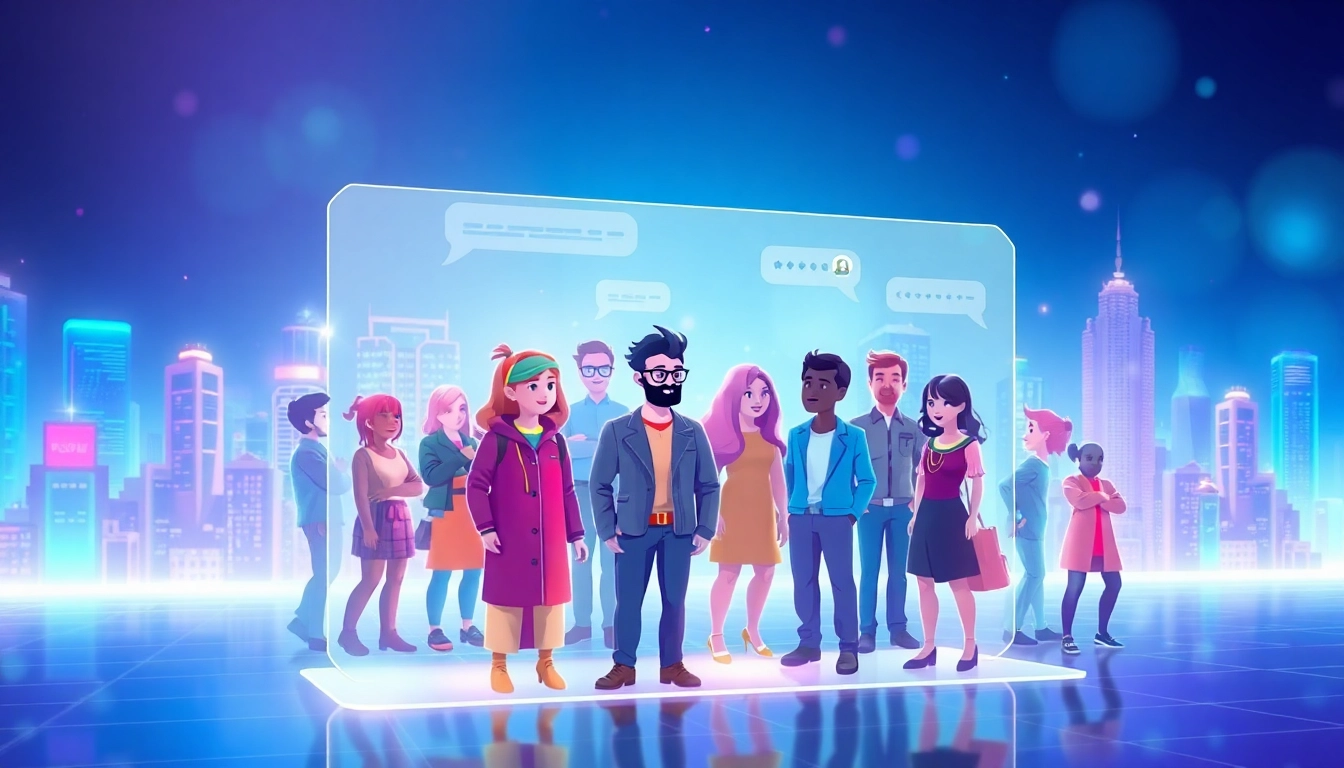1. Introduction to Character AI
The realm of artificial intelligence has seen an explosion of innovative technologies, one of the most fascinating being character ai. This technology brings forth a new dimension to digital interactions, allowing users to engage in conversations with simulated characters that are designed to respond in human-like ways. As society embraces more immersive experiences, particularly in gaming and virtual reality, understanding the construct and capabilities of Character AI becomes vital for users and developers alike.
1.1 What is Character AI?
Character AI refers to the technology behind interactive chatbots and virtual characters that simulate conversation and exhibit personality traits. Using advanced machine learning algorithms and natural language processing (NLP), these AIs can understand context, manage dialogue, and respond in a manner that feels natural to humans. They serve various purposes—from entertainment and companionship to education and customer service. As a result, Character AI provides an array of opportunities for personal engagement, creativity, and efficiency across numerous industries.
1.2 History and Development of Character AI
The evolution of Character AI traces back to early days of computer simulations and basic chatbot systems. One of the seminal advancements came with ELIZA in the 1960s, a program developed at MIT that could mimic conversation. As language processing capabilities improved through the decades, the foundation was laid for more sophisticated AI frameworks. By the late 2010s, deep learning techniques ushered in a new era for AI, allowing for the development of systems like GPT-3 that could generate coherent and context-aware responses. Character AI is a culmination of these advancements, creating interactive experiences that can resonate with users and enhance their interactions.
1.3 Popular Use Cases of Character AI
Character AI has found applications across various domains:
- Gaming: Users can engage in rich storytelling experiences by interfacing with dynamic characters who respond intelligently to player choices.
- Text-Based Adventures: Focused on narrative exploration, character interactions can shape the story and provide tailored experiences.
- Education: AI-driven characters serve as tutors or companions, making learning engaging through personalized dialogues.
- Marketing and Customer Service: Brands utilize characters to provide personalized customer engagement, answering queries and promoting products.
- Social Engagement: Virtual companions can offer social interaction, alleviating feelings of loneliness and providing entertainment.
2. How Character AI Works
2.1 The Technology Behind Character AI
At its core, Character AI relies on a combination of machine learning, neural networks, and language processing technologies. These systems are trained on extensive datasets comprising conversations, narratives, and other text forms. Key components include:
- Natural Language Processing (NLP): Enables the AI to understand context, sentiment, and nuances in human language.
- Machine Learning Algorithms: Allow the AI to adapt and improve responses based on user interactions, enhancing conversational quality.
- Contextual Memory: Some character AIs possess the ability to remember previous interactions, allowing for continuity in dialogue, making conversations feel more natural.
2.2 Types of Interactions with Character AI
Character AI facilitates several types of interactions that can be classified into three primary categories:
- Dialogue-Based: Users engage in conversations where the character responds based on context and dialogue history.
- Role-Playing: Users can immerse themselves in narrative scenarios, where characters react dynamically to choices, offering varied narrative outcomes.
- Task-Oriented: Used primarily in customer service, where AI can handle inquiries, resolve issues, and guide users through processes.
2.3 Understanding Natural Language Processing in Character AI
NLP is the backbone of how Character AI operates. It allows the AI to “understand” and generate language that is both relevant and contextually appropriate. Key processes in NLP include:
- Tokenization: Splitting text into individual elements (words or phrases) to analyze their meanings.
- Sentiment Analysis: Evaluating emotions behind text, allowing characters to respond in a more empathetic and contextual manner.
- Entity Recognition: Identifying names, objects, and concepts within dialogue to enhance relevance in responses.
3. Benefits of Using Character AI
3.1 Enhancing User Engagement through Character AI
One of the most impactful benefits of Character AI is its ability to heighten user engagement. By creating relatable and dynamic characters, users are more likely to interact, leading to deeper connections. For instance, in gaming, players often invest more time in narratives where their dialogue choices have tangible impacts. Surveys have shown that user retention rates significantly increase when interactive elements enhance storytelling.
3.2 Cost-Effectiveness and Accessibility
Character AI also represents a cost-effective solution for businesses. Automating customer service inquiries with AI can reduce the need for large support teams, thus decreasing operational costs. Not only does this save money, but it also enhances response times, providing users with instant engagement. Moreover, these automated systems can be available 24/7, ensuring that users can receive assistance at any time.
3.3 Impacts on Social Interaction and Creativity
Character AI plays a significant role in fostering social interaction, especially in a world where digital connections are becoming more prevalent. Virtual companions can stimulate conversations and help alleviate feelings of isolation. They also serve as platforms for creativity, enabling users to explore different narratives and scenarios, ultimately stimulating imagination and innovation in storytelling. In therapeutic settings, Chatbot characters have proven useful in role-playing exercises to bolster confidence and communication skills.
4. Challenges and Limitations of Character AI
4.1 Ethical Considerations in Character AI
As powerful as Character AI can be, it raises ethical concerns that need to be addressed. Issues around user data privacy, consent, and the potential for misuse of AI technology are of paramount importance. Developers must ensure that AI systems do not exploit sensitive information or generate harmful content. Clear guidelines and frameworks are necessary to ensure ethical usage, particularly in applications involving children or vulnerable groups.
4.2 Managing User Expectations and Limitations
Users often approach Character AI with high expectations, anticipating human-like interactions. However, it is essential to manage these expectations, as no AI system is perfect. Users may become frustrated with limitations, such as incorrect responses or lack of emotional nuance. Clear communication about the capabilities and limitations of Character AI is critical to fostering a positive user experience.
4.3 Ensuring Privacy and Security with Character AI
Privacy and security are critical aspects of Character AI systems. Developers are tasked with implementing strict data protection measures, ensuring users’ data is securely stored and not misused. Moreover, robust mechanisms must be in place to address data breaches or unauthorized access, reinforcing user trust and encouraging more interactions with AI systems.
5. The Future of Character AI
5.1 Emerging Trends in Character AI Technology
The future of Character AI is brimming with potential. As technology evolves, we can expect enhanced emotional intelligence and contextual understanding from these systems. Innovations such as augmented reality (AR) and virtual reality (VR) are likely to make the interactions even more immersive. Developers are exploring multisensory experiences where users may interact with characters through voice, visuals, and even haptic feedback, creating a near-realistic engagement.
5.2 Potential Market Growth and Opportunities
The market for Character AI is projected to expand significantly in coming years. Demand for personalized interactions in entertainment, education, and customer service is driving innovation. Companies that harness this technology are poised to gain a competitive edge in creating more immersive experiences that resonate with their audiences. Market studies indicate a growing acceptance of AI-driven approaches, paving the way for further adoption across sectors.
5.3 Predictions for Character AI in Daily Life
In the years ahead, Character AI is expected to become an integral part of daily life, integrating into homes, workplaces, and public services. Virtual assistants may evolve into full-fledged characters equipped to provide not just information but emotional support and companionship. The implementation of AI in social environments could revolutionize how we interact with technology, fostering meaningful connections in an increasingly digital landscape.


